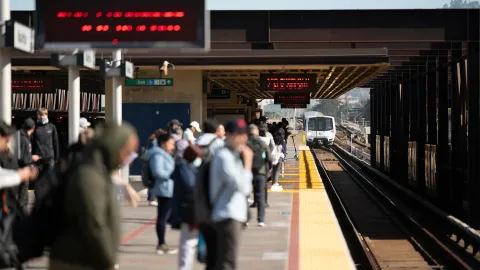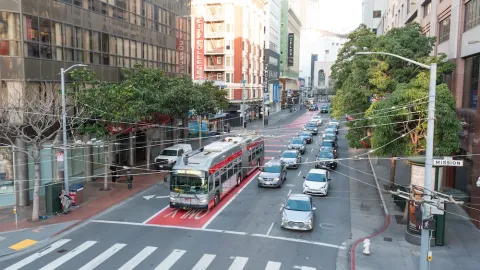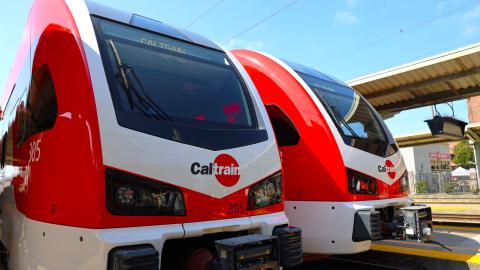
East Bay engineer Jono Finger wants a unique but imperiled element of Bay Area commuting to return: casual carpooling.
The casual carpooling concept is simple: A driver stops at a designated area and loads up with fellow commuters heading in the same direction for work. Casual carpooling emerged in the 1970s as an alternative to both transit and solo driving for San Francisco-bound commuters. Casual carpooling was highlighted as a go-to option during the 2013 BART strikes.
It had largely thrived in East Bay and Solano County communities until the Covid-induced upheavals of early 2020. While Covid-19 has hurt public transit, it all but has put an end to casual carpooling, Finger noted on a recent KGO-TV report on the issue.
Now Finger, who lives in Albany, has put together a survey to gauge commuters' interest in bringing back casual carpooling. That survey can be found here: https://sfcarpool.app/survey.
Finger answered questions about casual carpooling for The Bay Link:
Are you a former casual carpooler yourself? Pre-pandemic I was carpooling five days a week as a passenger for many years. From North Berkeley BART, in the morning. I have carpooled on and off for decades. When I was a kid my parents commuted to the city and regularly picked up passengers in the designated carpool line at North Berkeley BART and dropped them off at the Transbay Terminal or in the Financial District. I am a proponent of public transit and work in urban planning transit technology. But if drivers are going to drive, it's a win-win situation for them to pick someone up. The drivers and passengers get to the city faster and cheaper and it reduces congestion and emissions.
What kind of information do you hope to glean from the survey? First and foremost we want to know if there is genuine interest in casual carpooling and if there are enough people who want to be a part of bringing this back. We have questions about the difficulties people are having with carpooling. Some of the answers are beginning to shed light on reasons why this is happening. When we know there is a specific issue (i.e. - weak signage at the curbs), we can work on getting that resolved. We are open to suggestions for improving outreach and the survey itself so any feedback we receive is useful. Professionally, I am a programmer and have little marketing experience so any feedback we can collect is helpful.
How many responses do you think you need to get meaningful data? At its peak, there were thousands of people carpooling every morning from multiple locations in the East Bay, so a minimum of one thousand responses would be ideal. We would like to decide on a course of action and will look for trends in answers. If there are any standout upvoted options that suggest we move in a particular direction, we will take it.
How can this data be used to revive casual carpooling? We can improve our general outreach approach. We can improve physical signage. We can improve our technological solutions. Perhaps we will find we need to reach out to specific city and transit agencies and officials who may help drive this. Or maybe someone knows of other cities that have managed to revive their carpools who we should talk to. I think there are many directions we can take this.
Would you expect post-pandemic casual carpooling to be just a Tuesday-Wednesday-Thursday thing, or can it work on Mondays and Fridays too? I think this depends on what businesses do in terms of requiring employees to be in-office. If they start to want people to come to work more often, it could eventually be every day. My guess is in the next couple years, as companies start to forget the pandemic, more workers will be required to commute. Regardless, starting small would be great. Getting carpooling working reliably two days a week would be a major win. According to data collected from past decades, this could mean removing hundreds of cars from the roads.
Can casual carpooling get back to pre-pandemic usage numbers and variety of pickup locations? I think we could get the numbers back. If we can start with a small critical mass, it will continue to grow just due to visibility — much like the original casual carpool did in the 1970s. In terms of locations, I really only know the location I regularly use. While there is a shared culture to casual carpooling, I presume there is some variability among commuters who frequent different BART stations. If we can get it working at one station, we will use what we learned to roll out to others.
Should passengers give the driver a little cash to cover tolls, gas, wear and tear? Since there is no authority on casual carpooling, there are no hard and fast rules. However there is conventional etiquette. Drivers may ask for a contribution — some even put a little sign in the car so they don't have to verbalize the request. And passengers often contribute 1-3 dollars. I myself end up contributing half the time — not everyone carries dollar bills these days. The RapidCarpool app has a built-in payment system, which is minimal and I believe it varies with the time of day.
Radio on or off? As the tradition holds: NPR played at a reasonable volume.



Submit your comment
In order to receive a reply to your comment, please provide an email address.